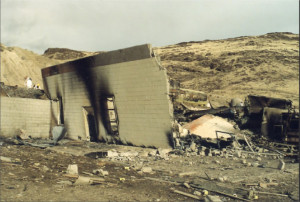At 7:54 a.m., two massive explosions 3.5 s apart destroyed an explosives manufacturing plant, killing 4 workers and injuring 6 others among the 11employees present. The explosions had the force of a magnitude 2.0 earthquake and were felt some 30 km away. The two explosions destroyed buildings, blew down walls, and hurled debris as far as 915 m. Fearing further blasts, fire-fighters did not attempt to extinguish fires at the site, and the flames burned for more than a day; about 21 t of explosives were consumed during the accident. The facility was never rebuilt.
The initial explosion occurred in a room where workers made boosters small explosive devices used in the mining industry to detonate larger explosives. A second, more powerful blast destroyed a building used for drying explosives, leaving a 12-by-18-m crater that was up to 1.8 m deep.
Producing boosters involved melting, mixing, blending, and pouring trinitrotoluene (TNT) and other raw materials into cardboard cylinders. The work was performed inside Booster Rooms 1 and 2, which were located in two adjoining buildings. In a separate building the chemical pentaerythritol tetranitrate (PETN) was dried before being transferred to the booster production buildings. PETN is one of the strongest high explosives known, and is transported wet due to its instability.
Booster Room 2 had housed four large freestanding mixing pots, where explosive materials were melted and blended. The day before the accident a worker had departed early, leaving 23 to 42 kg of melted base material in the bottom of one of the mixing pots. The worker apparently believed that another operator would use the leftover base material later that afternoon. Instead, the material remained in the pot and solidified overnight as outside temperatures fell below freezing. The next morning, the worker returned to Booster Room 2. Assuming that the pot had been emptied, and without checking its contents, he turned on the motor to the agitator blades, setting off the first detonation (either by simple friction of the hardened explosives or because of a foreign metal object, the raw materials being purchased as demilitarized munitions containing frequently nuts or bolts. Despite, those were not screened prior to use ).
The shock wave from the initial blast detonated several thousand kg of explosives stored inside the booster room. Heavy debris from this explosion rained down onto the PETN drying building 67 m away, piercing the roof and initiating an even larger secondary explosion.
The investigation carried out by the CSB revealed a lack of adherence to various process safety principles : no workers were involved in conducting the company’s process hazard analysis for the booster operation, and the scope of that analysis did not extend to Booster Room 2. Plant managers did not understand the hazards of the materials in use incorrectly believing that they were almost impossible to detonate without using a blasting cap. The investigation also showed the lack of written procedures and training (e.g. workers regularly used metal tools ). Plant design was insufficient and even minimal safety distances were not respected. Raw materials, equipment, and work procedures were altered without an analysis of the hazards of these changes.
Furthermore, the majority of workers spoke only Spanish, but the plant had no operational policies, safety videos or procedures in that language. The information relied only upon informal translation, created opportunities for error and miscommunication.
Finally the state inspectors had little formal training in explosives, and the state’s most recent safety inspection (in 1996) had focused on industrial hygiene.




